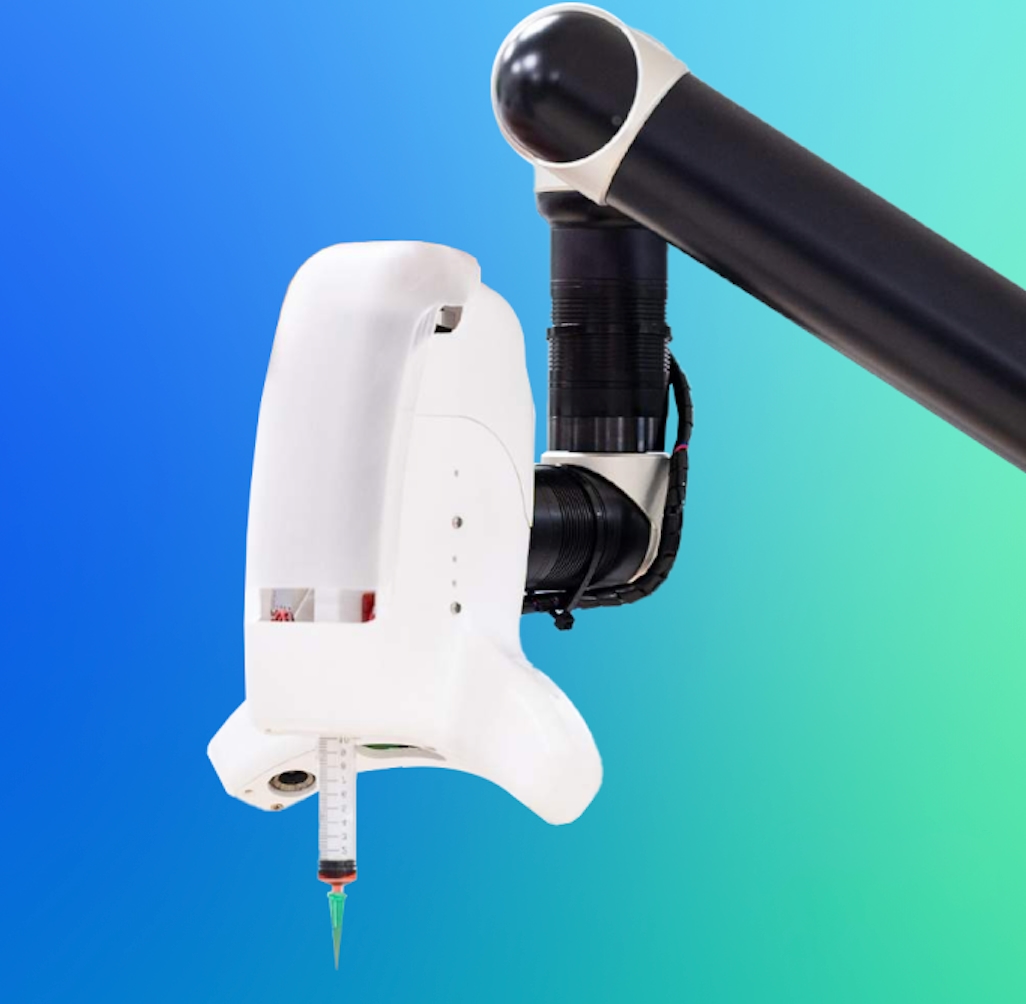Catalog
Search
60 products
View:
- Selected: 0Areas of use
- Selected: 0Item names
- Selected: 0Manufacturer
- Selected: 1Made in
- Selected: 0Additional
View:
60 products
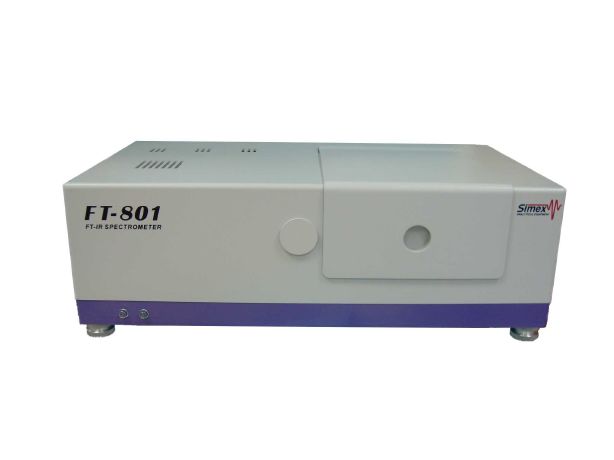
FT-801 IR Fourier spectrometer
It is designed for recording absorption spectra of solid, liquid and gaseous substances in the near and middle IR region (including drugs, lacquers and paints, petroleum products, explosives, pharmacological preparations, polymer films and fibers) with their subsequent identification, as well as for qualitative and quantitative analysis of mixtures containing several components.
SIMEKS
Novosibirsk
Produced in: Novosibirsk
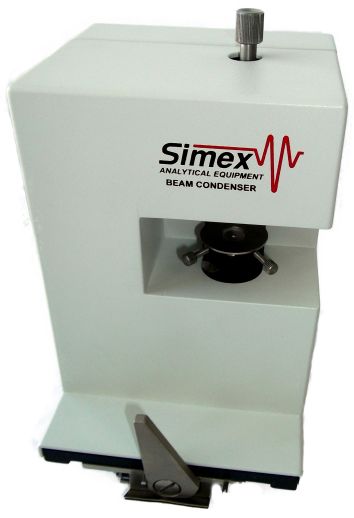
Focusing prefix MKF-Yu
It allows recording transmission spectra of objects with sizes from 500 microns (precious stones, optical parts, semiconductor materials).
It is also used in the study of samples compressed into small-diameter tablets with KBr (the method is convenient for spectral analysis of powdery substances - the prefix allows you to work with small amounts of the sample using a manual press for the manufacture of tablets).
• The diameter of the focus spot is less than 3 mm
• The design uses parabolic mirror optics
• The set-top box is equipped with a set of replaceable diaphragm holders for samples of different sizes
• Windows-substrates made of IR-transparent materials can be placed in the holder after pasty, liquid substances or extracts are applied to them, followed by drying of the layers
• The slide table has the possibility of smooth movement in vertical and horizontal directions to achieve the maximum signal level
SIMEKS
Novosibirsk
Produced in: Novosibirsk
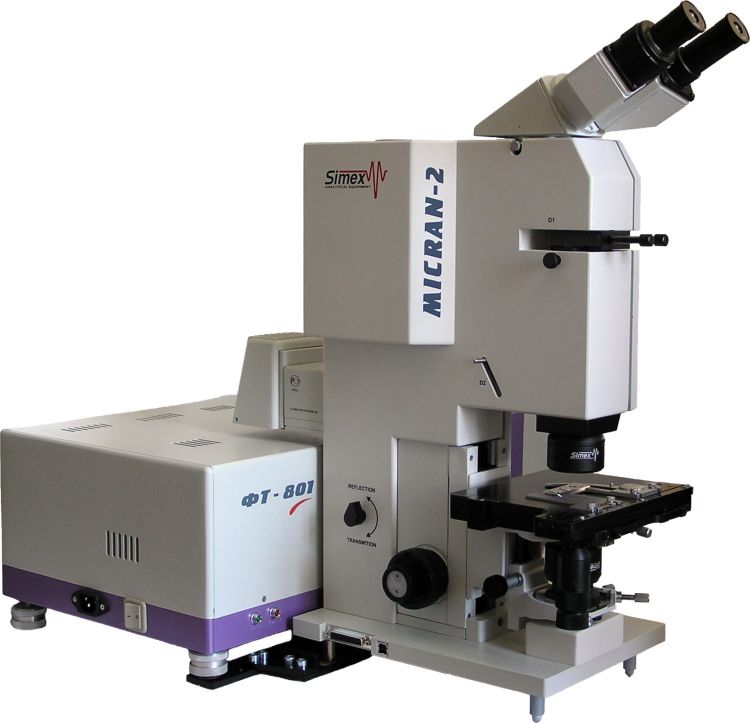
Spectral measuring complex: automated IR Fourier spectrometer "FT-801" with IR microscope "MIKRAN-2"
2 supp.
from
100 500 ₽
The wide-range IR microscope of the MICRAN series, connected to the FT-801 and Infralum FT-801 Fourier spectrometers, is designed to study samples from 10 microns in size, including heterogeneous in composition. When working on an IR microscope, the operator has the opportunity to observe the object under study with a magnification of over 200X both using binoculars and on a monitor using a digital video camera, during photometry, select a local area of arbitrary shape with the help of diaphragms, and also “scan” the surface of the sample, observing the spectrum obtained in real time.
SIMEKS
Novosibirsk
Produced in: Novosibirsk
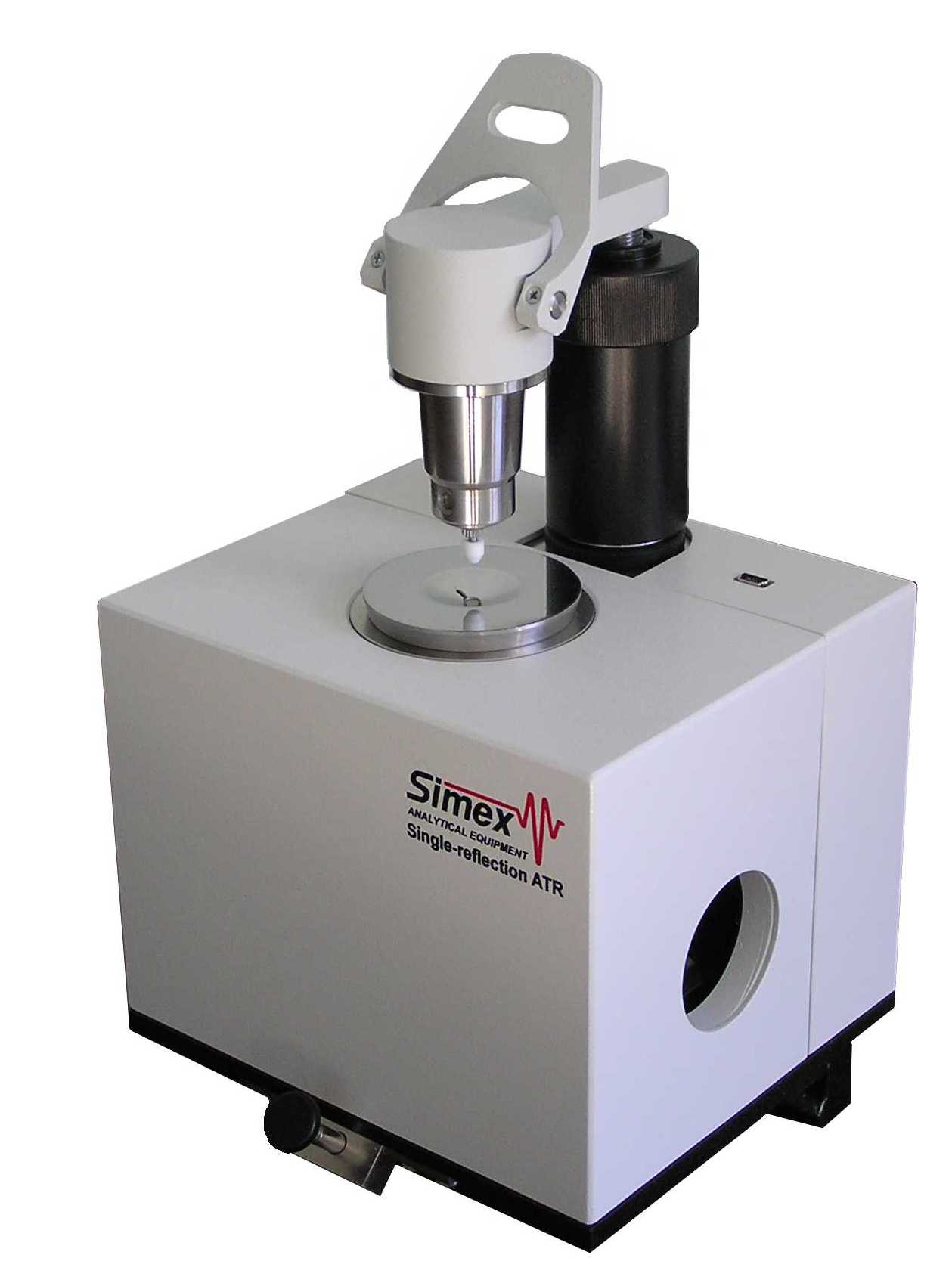
Universal optical set-top box with zinc selenide element and integrated visualization system on an external monitor
It is intended for express analysis of various types of solid and liquid samples, including polymer particles, films and fibers, powdery substances, fragments of paint coatings, fuels and lubricants. The presence of an optical system for visual inspection of the surface under study with an increase of 75X ensures high efficiency when working with small samples – fragments of thin fibers, microparticles, etc. The universal clamp is equipped with a precision lever mechanism for quickly lowering the tip and a micrometer screw that allows you to pre–set the optimal degree of pressure - this ensures quick sample change and repeatability of the results during measurements. For convenience when working with liquid and paste-like samples, as well as in the ZDO mode, it is possible to rotate the clamping console by 180o. The console is equipped with two replaceable tips – with a spherical working part and with a flat hinged head.
A replacement table is used to register the specular and diffuse reflection spectra. The sample is located on the subject plane of the investigated surface downwards, the angle of incidence of the central beam on the sample is 45 °. The method is used to determine the spectral characteristics of optical parts, crystals, thin films on the surface, as well as to register the absorption spectra of large solid objects.
Transmission in the operating range of the spectrum, % of the input signal at least 30
The recommended number of scans when registering spectra is 25
Spectrum registration time at 25 scans (resolution 4 cm-1), sec 30
The depth of penetration of radiation into the sample, microns 5 – 15
Minimum area of a solid sample, mm 0.2 × 0.2
Minimum volume of the liquid under study, ml 1
Minimum dimensions of the fiber sample: cross-section diameter/length, mm 0.1/1
Substrate crystal material ZnSe CVD, Ge
Focusing spot diameter, mm 1
The angle of incidence of radiation (central beam) on the sample in the ZDO mode 45o
Magnification of the micro lens / total magnification of the visual channel 4X /75X
Field of view of the optical system, mm 2 X 2.5
Digital video camera resolution 640 X 480
Overall dimensions, mm 150×150×260
Weight, kg 2.15
• Allows you to study objects of small size (from 200 microns - depending on the geometry, surface quality and physico-chemical properties of the material)
• The attachment allows you to work without sample preparation, has a fixed adjustment of the pressure on the sample using a clamp equipped with color indicators
• Thanks to the removable flange with the NPVO element, a quick and convenient sample change and cleaning of the crystal surface is provided
• At a given optimal contact force, the method provides high quality and repeatability of results due to the absence of influence of the thickness of the substance layer on the shape of the spectrum and the intensity of the absorption bands
• The sample retains its original physical and chemical properties and, if necessary, can be further investigated by other methods
SIMEKS
Novosibirsk
Produced in: Novosibirsk
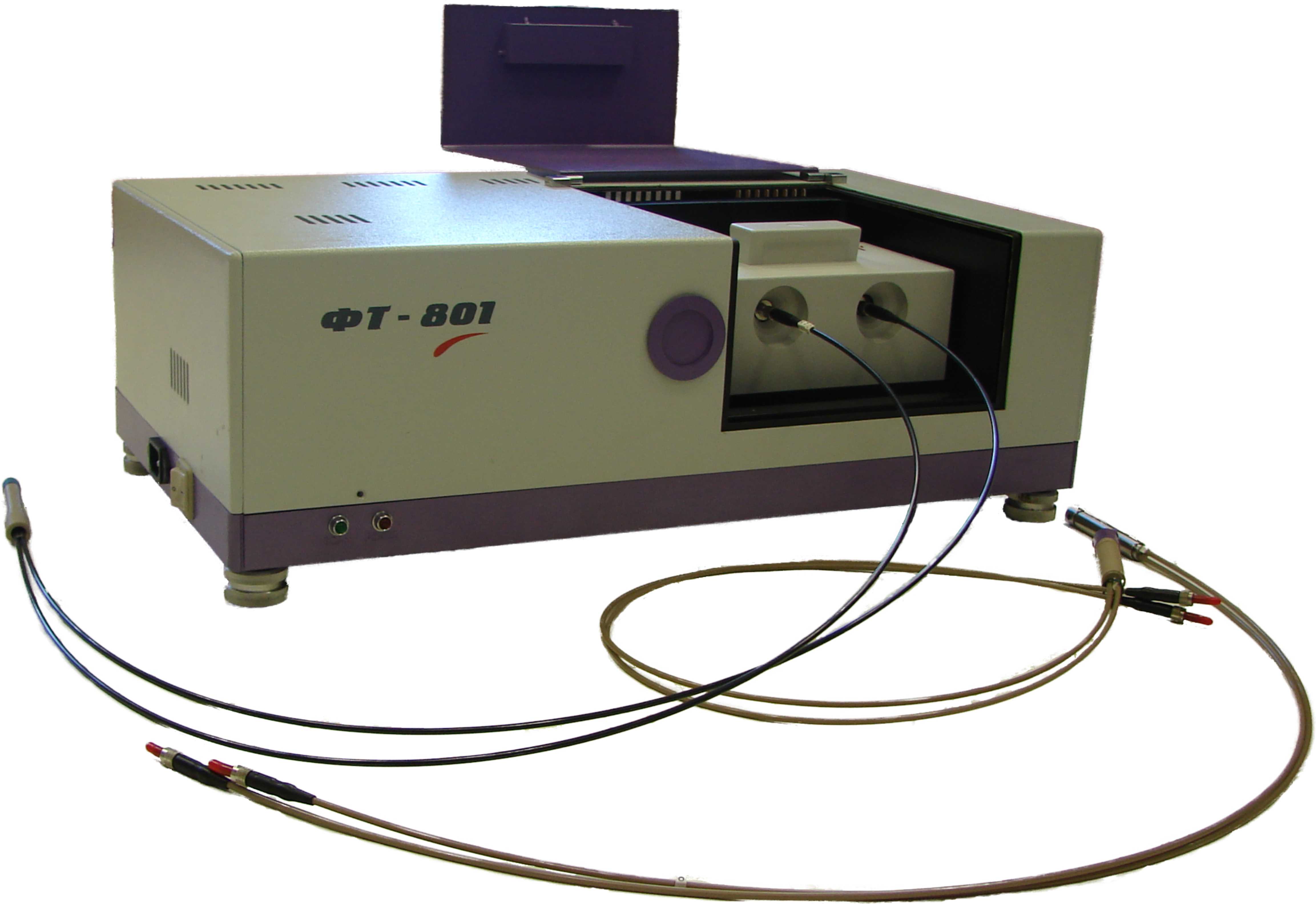
Optical set-top box for working with light-guide IR probes
FT-801 IR Fourier spectrometers can additionally be equipped with a special optical set-top box that allows efficient use of light-guide systems.
4 types of light-guide probes allow measuring transmission and reflection spectra in solid, liquid and gaseous media
Modern IR light guides have high intrinsic transmittance and sufficient mechanical strength, which makes it possible to transfer measurements from the laboratory directly to production - to control the flow of technological processes, check the quality of raw materials and finished products.
Application areas:
· Chemical and microbiological industry
· Pharmaceutical industry
· Medicine and Cosmetology
· Food industry
· Petroleum products, fuels and lubricants
· Criminology
SIMEKS
Novosibirsk
Produced in: Novosibirsk
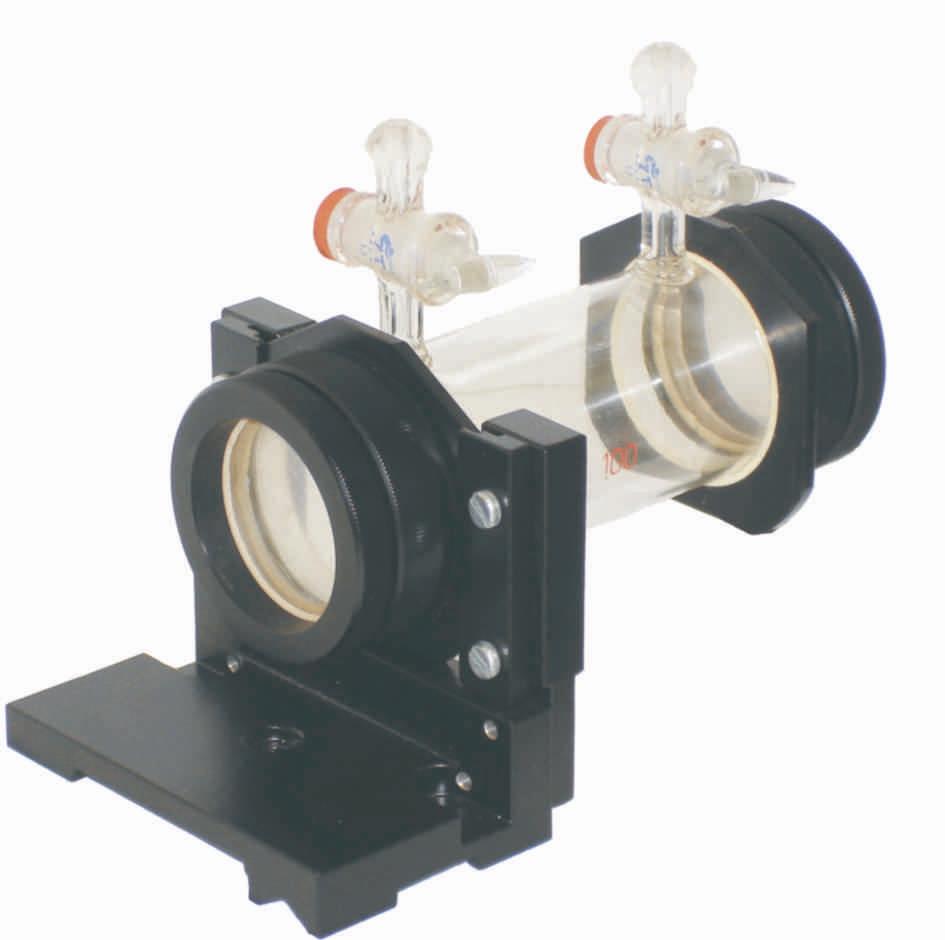
Single- and multi-pass gas cuvettes
Single- and multi-pass flask are used for qualitative and quantitative spectral analysis of gas mixtures. The use of multi-pass flask makes it possible to confidently detect extremely small concentrations of the components of the gas under study (less than ppm units).
• Three types of flask are supplied:
1. single-pass, having a stroke length of 100 mm, with a glass body and windows made of ZnSe, KBr, NaCl
2. multi-pass, with a beam stroke length of up to several tens of meters
3. multi-pass, with a beam stroke length of up to several tens of meters, equipped with a heating system of the working chamber up to 200 ° C and a thermal controller
Multi-pass cuvettes have a transparent working chamber made of quartz glass; mirrors with a gold (99.999) coating provide a reflection coefficient in the IR region of at least 98%; additionally, cuvettes can be equipped with pressure and temperature sensors, fittings for controlling gas flow, etc.
SIMEKS
Novosibirsk
Produced in: Novosibirsk
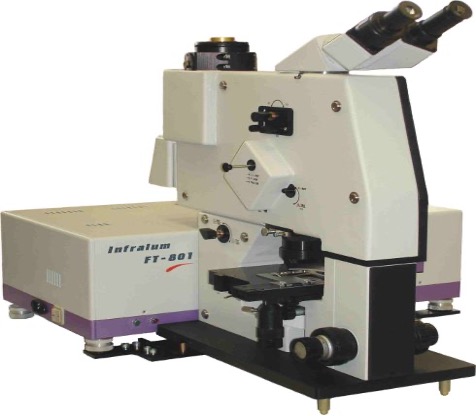
IR microscope "MIKRAN"
The IR microscope "MIKRAN" is designed to work with IR Fourier spectrometers "Infralum FT-801". The spectral range is 6000 – 600 cm-1 (with a microscope and an MST detector cooled with liquid nitrogen). Resolution 0.5, 1, 2, 4, 8 cm-1 (determined by the resolution of the Fourier spectrometer)
SIMEKS
Novosibirsk
Produced in: Novosibirsk
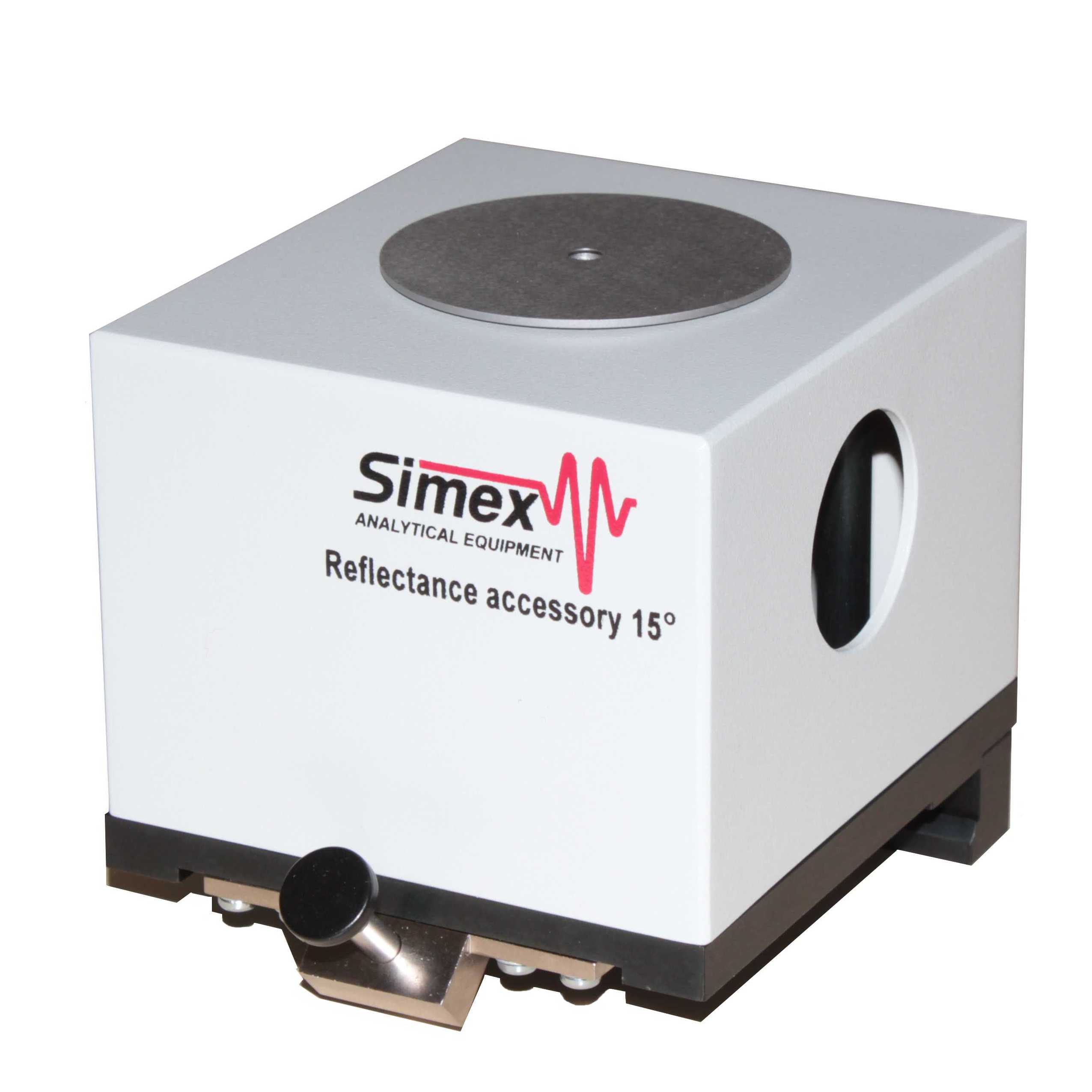
Reflection prefix PO-15 V
Designed for the study of various types of solid samples, including optical and semiconductor materials, precious stones and other objects of arbitrary shape
• The sample is located on the subject plane of the investigated surface downwards, the angle of incidence of the central beam on the sample is 15 °
• Allows you to examine samples of small sizes (the diameter of the test area is from 1 mm)
• The set-top box is equipped with a set of replaceable diaphragm holders for samples of different sizes
• When using a mini-press, it allows you to examine samples in the form of a thin layer rolled out on a mirror plate made of alloy steel (radiation passes through the substance layer twice, reflecting from the mirror surface)
• Not used: for the study of bulk and liquid substances
SIMEKS
Novosibirsk
Produced in: Novosibirsk

Liquid flask with adjustable thickness of the test liquid layer
A liquid flask with an adjustable layer thickness of the liquid under study is made in the form of an optical-mechanical attachment installed in the cuvette compartment of the FT-801 spectrometer. It contains focusing optics, removable holders of two windows-substrates with a diameter of 10 mm and two adjusting screws placed on the upper panel of the console housing and designed to set the required gap between the windows.
A liquid of any degree of viscosity is pre-applied in the form of a small drop to the lower window and then, in the process of smooth convergence of the windows, evenly fills the gap between them. By rotating the adjusting screws and observing the transmission spectrum online, the user has the opportunity to set the desired thickness of the liquid layer, guided by the overall intensity of the entire spectrum or by the intensity of specific absorption bands. In the presence of calibration, which is easy to create using the ZaIR 3.5 program for several samples with a known concentration, the cuvette allows quantitative measurements. The flask is indispensable in the analysis of mixtures containing impurities in small proportions.
Technical specifications
Transmission in the operating range of the spectrum, % of the input signal at least 50
The recommended number of scans when registering spectra is 16
Time of spectrum registration at 16 scans (resolution 4 cm-1), sec 20
Minimum volume of the studied liquid, mm3 1
The diameter of the focus spot, mm 3
Overall dimensions, mm 200×90×160
Weight, kg 1,1
The figure shows several spectra of the viscous lubricant "Buxol", illustrating the process of selecting the thickness of the sample layer between the windows.
The measurement process has a high expressiveness and reproducibility, inexpensive replaceable substrate windows are used, the system is easy to configure and clean, a very small amount of sample is required to obtain high-quality spectra.
SIMEKS
Novosibirsk
Produced in: Novosibirsk
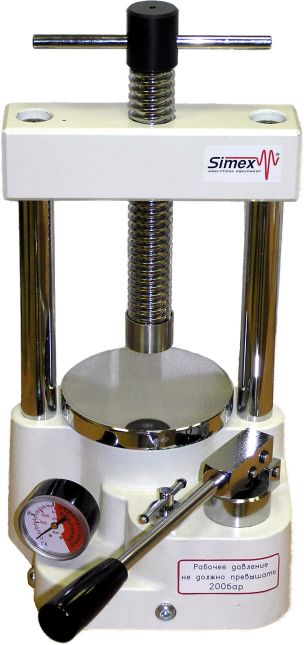
Hydraulic press GP 200-13
Designed for the preparation of samples in the form of compressed tablets with a diameter of up to 13 mm, consisting of the test substance in a mixture with microcrystalline potassium bromide (KBr).
- the principle of operation of the press is based on the injection of pressure in the hydraulic system by swinging the lever.
- to control the working pressure, the press is equipped with a pressure gauge
- complete with a press, molds with a diameter of 13 mm and 3.5 mm can be used
- for the study of finished samples on a Fourier spectrometer, a KBr tablet holder and D13mm substrate windows or a microfocusing attachment (for 3.5 mm tablets) is used
SIMEKS
Novosibirsk
Produced in: Novosibirsk
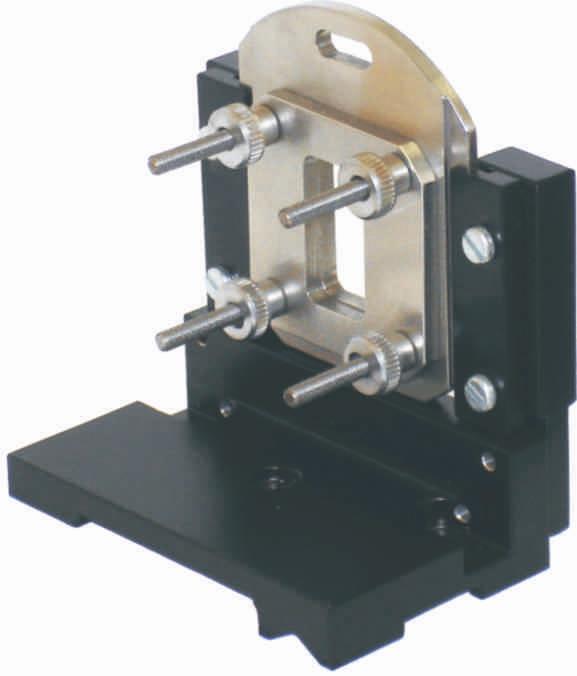
Universal holder of solid samples of various thicknesses and films
It is used for recording transmission spectra of medium–sized and arbitrary-shaped solid samples - polymer films of various thicknesses, optical parts, semiconductor wafers, large crystals, etc.
• Thanks to quick-release nuts, it provides convenient fastening of samples
SIMEKS
Novosibirsk
Produced in: Novosibirsk

Chromatograph Milichrome A-02
Overall dimensions: 550x230x350 mm
Weight (without computer): ~17 kg
Power consumption: up to 200 watts
Warranty service : 1 year
Detector
Two-beam spectrophotometer
Spectral range – 190-360 nm
Simultaneous detection at 1-8 wavelengths
Cell volume – 1.2 µl
Noise <0.0001 E.O.P. at 250 nm
Drift <0.00005 E.O.P./hour at 250 nm
Column
Ø2x75 mm stainless steel
The efficiency of the column is up to 6000 theoretical plates
Thermostat
Solid-state electric
Set temperature from 35 to 90°C
The discreteness of the temperature setting is 1 °C
Temperature control error ±0.3°C
Pump
Two-pronged, gradient
The feed rate is from 5 to 1000 µl/min, the
maximum pressure is 70 atm
. The gradient is formed from 1 to 20 linear sections
Automatic doser
Automatic, programmable
Number of test tubes – 46
The number of analyses in the series is from 1 to 200
The dosed volume is from 1 to 99 µl
Test tubes made of glass with a volume of 200 µl
Polyethylene tube stoppers
Software
OS: Windows® XP/7/10
Milichrome A-02™, Multichrome™, Alphachrome, Alphaspectrum
EkoNova
Novosibirsk
Produced in: Novosibirsk
